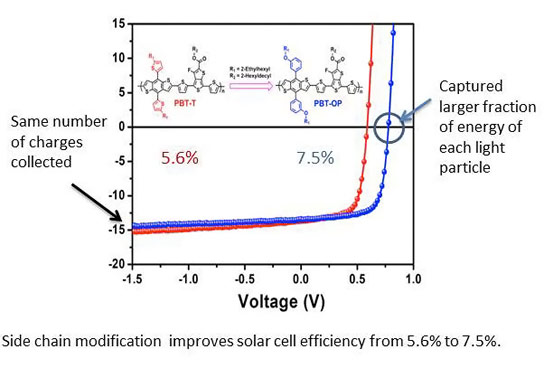
By modifying the molecular structure of a polymer used in solar cells, an international team of researchers has increased solar efficiency by more than thirty percent.
Researchers from North Carolina State University and the Chinese Academy of Sciences have found an easy way to modify the molecular structure of a polymer commonly used in solar cells. Their modification can increase solar cell efficiency by more than 30 percent.
Polymer-based solar cells have two domains, consisting of an electron acceptor and an electron donor material. Excitons are the energy particles created by solar cells when light is absorbed. In order to be harnessed effectively as an energy source, excitons must be able to travel quickly to the interface of the donor and acceptor domains and retain as much of the light’s energy as possible.
One way to increase solar cell efficiency is to adjust the difference between the highest occupied molecular orbit (HOMO) of the acceptor and lowest unoccupied molecular orbit (LUMO) levels of the polymer so that the exciton can be harvested with minimal loss. One of the most common ways to accomplish this is by adding a fluorine atom to the polymer’s molecular backbone, a difficult, multi-step process that can increase the solar cell’s performance, but has considerable material fabrication costs.
A team of chemists led by Jianhui Hou from the Chinese Academy of Sciences created a polymer known as PBT-OP from two commercially available monomers and one easily synthesized monomer. Wei Ma, a post-doctoral physics researcher from NC State and corresponding author on a paper describing the research, conducted the X-ray analysis of the polymer’s structure and the donor:acceptor morphology.
PBT-OP was not only easier to make than other commonly used polymers, but a simple manipulation of its chemical structure gave it a lower HOMO level than had been seen in other polymers with the same molecular backbone. PBT-OP showed an open circuit voltage (the voltage available from a solar cell) value of 0.78 volts, a 36 percent increase over the ~ 0.6 volts average from similar polymers.
According to NC State physicist and co-author Harald Ade, the team’s approach has several advantages. “The possible drawback in changing the molecular structure of these materials is that you may enhance one aspect of the solar cell but inadvertently create unintended consequences in devices that defeat the initial intent,” he says. “In this case, we have found a chemically easy way to change the electronic structure and enhance device efficiency by capturing a larger fraction of the light’s energy, without changing the material’s ability to absorb, create and transport energy.”
The researchers’ findings appear in Advanced Materials. The research was funded by the U.S. Department of Energy, Office of Science, Basic Energy Science, and the Chinese Ministry of Science and Technology. Dr. Maojie Zhang synthesized the polymers; Xia Guo, Shaoqing Zhang, and Lijun Huo from the Chinese Academy of Sciences also contributed to the work.
Reference: “An Easy and Effective Method to Modulate Molecular Energy Level of the Polymer Based on Benzodithiophene for the Application in Polymer Solar Cells” by Maojie Zhang, Xia Guo, Wei Ma, Shaoqing Zhang, Lijun Huo, Harald Ade and Jianhui Hou, 17 December 2013, Advanced Materials.
DOI: 10.1002/adma.201304631